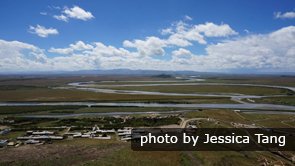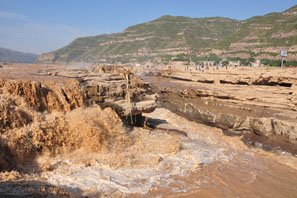The Yellow River overflows with shocking facts. China's "Mother River" gave a home to early civilization, then regularly devastated it with deadly floods and course shifts. China's recent infrastructure boom has fully harnessed the Yellow River for hydroelectricity, reservoirs, irrigation, etc., turning the "monster" into a natural resource.
Sixth Longest River - Huge Torrent to Muddy Trickle

The First Bend of the Yellow River on the Sichuan-Gansu border
The Yellow River, is the second longest river in China after the Yangtze, and the sixth longest in the world, but less than the 100th for discharge. It dominates dry northern China. Unlike other rivers, it seems to decrease in flow as it goes.
Length: 5,464 km (3,398 mi)
Source: the Bayankala Mountains, Qinghai Province, western central China
Mouth: the Bo Sea at Shandong Province, a gulf on the East China Sea
Cradle of Chinese Civilization
Chinese people say the Yellow River is "the Mother River of China" and "the Cradle of Chinese Civilization". Historical evidence shows that the lower Yellow River basin was where Chinese civilization began, and the most prosperous region in early Chinese history.

Peking Man statue at Zhoukoudian Anthropological Museum in Beijing
Prehistoric Chinese lived just north of the Yellow River Basin at
Zhoukoudian, south of Beijing, and around Sanmenxia on the Yellow River, midway between Xi'an and Zhengzhou. It was around Zhengzhou that
the earliest Chinese dynasties were based: the Xia (2100–1600 BC, capital Luoyang) and Shang (1600–1046 BC, capital Anyang) dynasties.
Xi'an, on the Wei tributary of the Yellow River, was a prominent Chinese capital in several dynasties from the Qin Dynasty (221–206 BC) to the Tang Dynasty (618–907). The Yellow River Basin was the center of Chinese politics, economy, culture, and innovation for about 3,000 years.
The Muddiest Major River on Earth
- Chinese name: 黄河 Huánghé /hwung-her/ ‘Yellow River'
- Alternative Chinese name: 浊河 Zhuóhé /jwor-her/ 'Muddy River'
The Yellow River got its name because of the ochre-yellow color of the muddy water in the lower reaches of the river. Each year, the river carries 1.6 billion tons of fine sediment (loess) when its middle reaches flows through China's Loess Plateau region. It carries more sediment per cubic meter than any other major river in the world, and deposits most of it long before it reaches the delta.
The World's Largest "Yellow" Waterfall — Hukou Waterfall

Hukou Waterfall — the most sedimented major waterfall in the world
Hukou Waterfall, in the middle reaches of the Yellow River, is the
largest "yellow" waterfall in the world, and the second largest waterfall in China after Huangguoshu Waterfall. The waterfall is named Hukou (壶口 /hoo-co/ ‘Kettle Mouth’) because the riverbed there has eroded into a spout
like an enormous teapot, from which the rushing "yellow" water pours out. When the mighty Yellow River flows through the gorge at Hukou, it abruptly narrows, turning the water into rapids, ending in
thundering chocolaty billows. The magnificent waterfall is 15 meters (50 feet) high and 30 to 50 meters (100–160 feet) wide, depending on the season. The marvelous scene of Hukou Waterfall attracts numerous tourists every year. Learn more about
Hukou Waterfall.
Ships Sail on a Raised River — 10m Above the Ground!
Usually, a river is the lowest point around — not so with the Yellow River! Due to sediment accumulation, and successive levees built to contain the raised flow, the riverbed is up to 10 meters (33 feet) above the surrounding cities and farmlands in most of its lower reaches. So it is also called "the Hanging River" or "Above Ground River". The Yellow River is the only river where ships sail overhead!
"China's Sorrow" Has Killed Millions by Flooding
Because of the continual rise of the riverbed caused by the accumulated silt, the river tends to overflow its banks, and sometimes leave its banks far behind (see below). Surrounding areas were extremely prone to flooding and river course change. The Yellow River has long been known as "China's Sorrow." It was the most destructive and dangerous river in the world, until damming and massive abstraction has reduced it to a carefully controlled trickle. Between 602 B.C. and 1946, it has flooded 1,593 times, each time killing thousands by drowning, disease, starvation, and loss of livelihood. The 1931 Yellow River Flood was the most devastating natural disaster ever recorded, killing 1–4 million (apart from famines and plagues).
Over 20 Major Moves — from Tianjin to Shanghai
3,000 years ago the Yellow River emptied into the Bo Sea near Tianjin and Beijing, 200 km north of where it does now. But in the last 1,000 years (and as recently as 1947) it has emptied into a tributary of the Yangtze, flowing out at Shanghai — 600 km south of its current delta. It has changed its course dramatically an average of about once every 100 years, causing huge devastation.
Reduced to Nothing Annually Since 1972
Due to decrease in rainfall in the Yellow River catchment, and increased demands for irrigation, etc., the lower reaches of the Yellow River dried up completely for the first time in 1972, and since then have dried up almost annually. When it dries up, over 140 million people and about 74,000 km² (46,000 mi2) of farmland are affected. In 1996, the dry period persisted for 136 days, and 226 days in 1997.
Billions Spent on Flood Control
Strengthening and building higher embankments (and dredging) protect the surrounding areas from the rising river. Building large-scale water conservation projects, including Sanmenxia Reservoir and Xiaolangdi Multipurpose Dam to control flow and sediment deposition downstream, captures excess water when needed. Planting trees in the watershed reduces erosion and resulting sedimentation, and runoff rates. Damming tributaries of the Yellow River also slows the river's flow.











 The First Bend of the Yellow River on the Sichuan-Gansu border
The First Bend of the Yellow River on the Sichuan-Gansu border
 Hukou Waterfall — the most sedimented major waterfall in the world
Hukou Waterfall — the most sedimented major waterfall in the world



